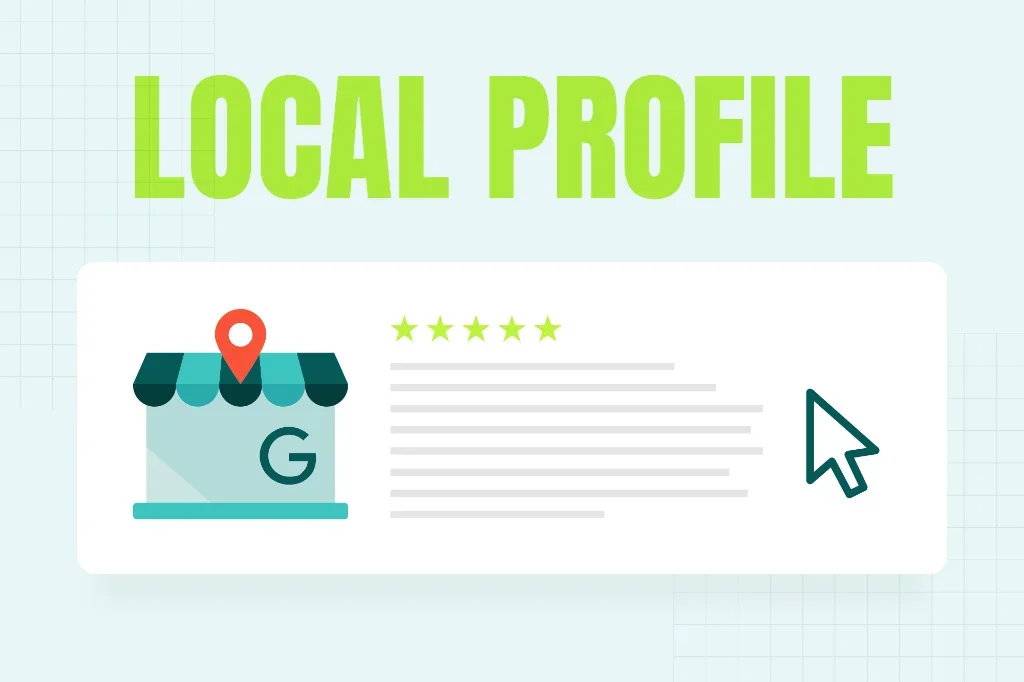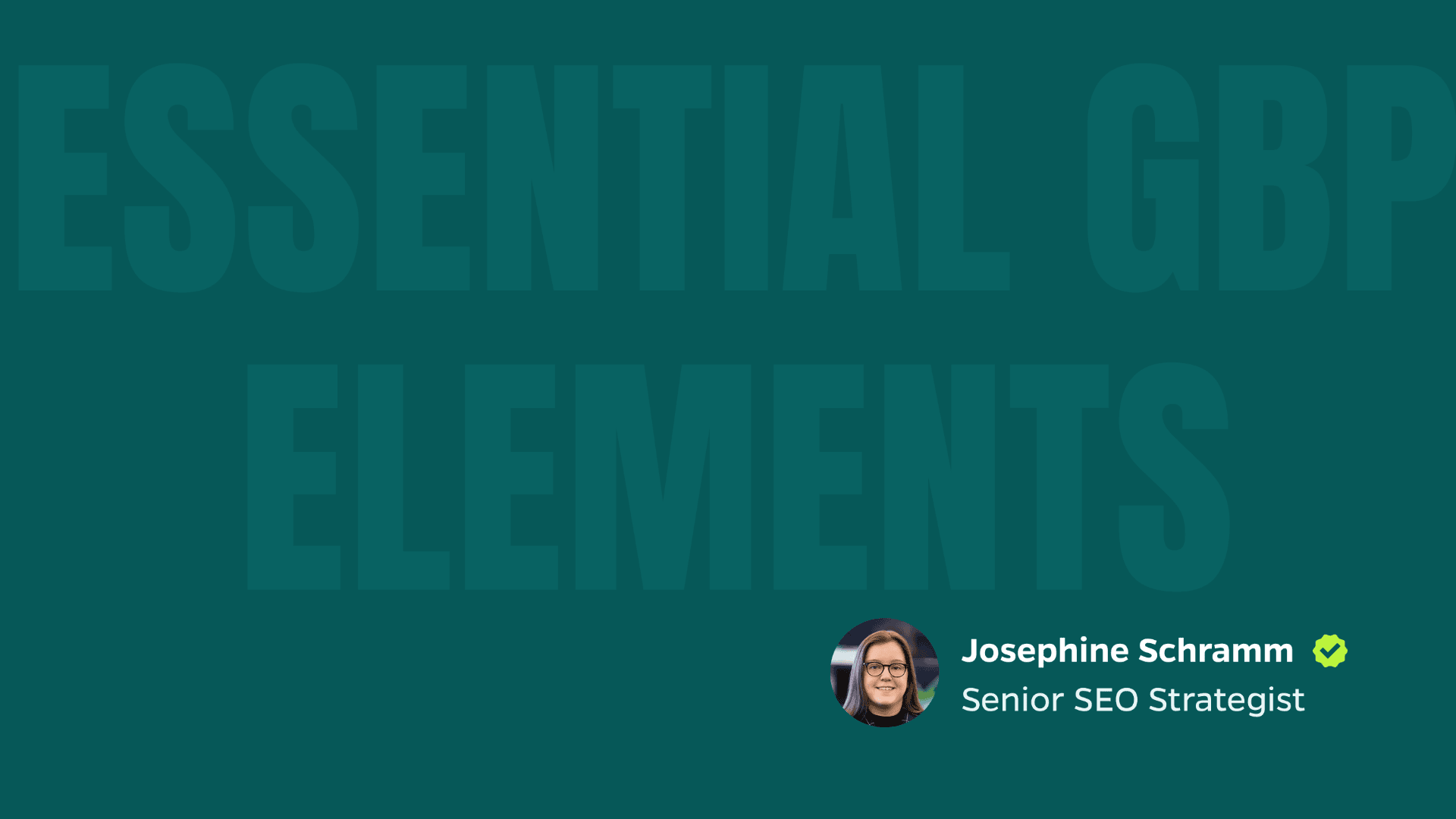It’s winter and it’s cold. Your pipes freeze and without warning, one bursts. You need to find a service fast to get your pipe fixed and the water flowing through them rather than onto your hardwood floors.
In this scenario like others, the homeowner is typing into a search engine “plumbing services in my area.” If you aren’t showing up in that search, or your business info isn’t updated, then you are missing out on a job opportunity. This is just one example of why local SEO is essential for business success.
Local SEO Expert Josephine Schramm shares important tips for how businesses can gain maximum local visibility on search engines. SEO is the most direct strategy for driving customers to the door. Make sure that you are showing up within your city and community for customers who are actively searching for your product or service.
I’d say almost half of all the Google searches have a local intent. So, plumber near me, or restaurants in Chicago. Mastering local search isn’t just about a marketing tactic, it’s fundamental for your business growth.
Who Benefits From Local SEO
When you think about who your customers are and where they are coming from to get to your business, it’s often local SEO that’s driving them there. Your marketing strategy should include local SEO to increase your visibility, get more local traffic, and grow your customer base in your geographical area. These places and more benefit from local SEO:
Businesses with physical locations that rely on foot traffic:
- Restaurants
- Cafes
- Retail stores
Service area businesses or those who travel to the customer’s location:
- Plumbers
- Electricians
- Landscapers
- Cleaners
Multi-location brands that have to manage independently:
- Chains
- Franchises
- Other businesses with more than one location
It takes some upfront work and some maintenance along the way, and you can grow your presence further to attract even more qualified leads. It starts with telling search engines more about your business.
Enhance Your Google Business Profile (GBP)
Google’s primary goal is to provide searchers with accurate information. That’s why Google Business Profile is worth the effort for businesses with a local presence. It boosts your visibility in Google Search and Maps, and it helps customers find your business easier. A fully completed GBP ranks better because it signals trust and relevance to Google, and it tells Google that your business is legit, active, and provides a good user experience.

GBP and NAP Impact Ratings
Three of the biggest parts of your profile that will help make you stand out as a legitimate business are your name, address, and phone number (NAP). To start, be sure your business name listed is the official, real-world name. Adding any keywords goes against Google’s guidelines and can get your profile suspended.
Next, pay attention to the primary category. While it may make sense to be listed under a broader category, it’s more practical to make your primary category align with the exact type of business you do. Plumbers and electricians shouldn’t list under home services as their primary category. Rather, they should select “plumbing” and “electricians” to stay more specific and make themselves easier to find.

Essential GBP Elements
“The physical address is also important. A verifiable address within the searcher’s geographical area is fundamental to appearing in local searches for that area. A phone number as well. You can have multiple phone numbers, which is important for those that use call tracking services, but you also want to include a local phone number, too.”
These profile elements are essential, so Google and users can verify you easier as a business. Be sure to keep the info up to date. Go in at least quarterly or any time you update any of the information above.
Strengthen Your Local Visibility With GBP Posts
Think of GBP posts as micro-ads. They appear directly within your profile when someone finds you in Google Search or Google Maps, which increases your visibility and engagement.
Use these posts to communicate your offers and new things that you have happening within your business. The best part is that it’ll be visible on the search engine results page with whatever device you are using. Keep the posts short and benefit-driven and refresh them regularly.
Content Drives More Engagement
What will get people to click through to your page? Special offers and discounts get people’s attention quickly. If they were already thinking about visiting your establishment, it pushes them one step closer.
Also, use this space in your GBP to call out upcoming events, workshops, or community involvement. It will bring more visitors to your site and entice them to come and shop or dine.
People absorb information differently, so consider adding images to showcase products or recently completed projects. It’s another way to really showcase your work and to let a search engine and the person searching know that you are a legitimate business.
“Photos and videos build trust and help customers visualize the experience of doing business with you. They’re a pretty significant ranking engagement factor. Listings with more photos receive more clicks, calls, and direction requests. They prove you are a real, legitimate business, and showcase the quality of your work, products, and your work environment.”
Image Guidelines to Maximize Local Visibility and Engagement
Images of your business and what you do is another great way to attract potential customers. Follow these image guidelines for the best results.
Guideline | Details |
Quality | Use high-quality, clear, well-lit images. |
Resolution | Ensure all images are high-resolution to avoid pixelation. |
Relevance | Showcase your storefront, business interior, team, products, and services. |
Consistency | Keep image style and tone consistent to build brand trust. |
Extras (Optional) | Geotag images and add metadata for local SEO benefits. |
Frequency | Update images regularly to reflect your current business presence. |
Reviews Affect Local Search Ratings
Imagine a person is searching for the best bakery in town. They will be sure to check out reviews and see what customers have said prior to heading your way. Google has confirmed that customer reviews play a significant role as a local ranking factor. It’s not just that the reviews exist, Google is also looking at how they are accumulated and maintained over time.
Factors such as volume of reviews signal credibility and trustworthiness. Velocity looks at how fast the reviews are being generated. If you get 100 reviews in 10 minutes, it can look unnatural, and you may get flagged. Finally, it’s checking out the frequency of how often the reviews are received. If your business gets a steady fresh flow of feedback, that’s a good signal to Google of customer engagement.
When customers also add keywords to their reviews that helps as well. If you are a roofer and someone says “Thanks for fixing my roof. You are a great roofing repair company,” that’s another thing Google will pick up.

Encouraging Customer Reviews
Try out different techniques to get feedback from customers. You can ask them directly to leave you a review. But there are also automated follow-ups through email, SMS, and QR codes.
Restaurants often have QR codes at your table, on your receipt, or as you walk out. The links will go directly to the GBP where customers can add their reviews. It’s important to not offer an incentive for people leaving the reviews though, as that goes against Google’s guidelines.
When the reviews are flowing in, make sure you take time to respond and thank people for sharing. Sometimes, though, the reviews are unfavorable. That’s when you need to respond quickly with both professionalism and empathy.

Responding to Unfavorable Reviews
First and foremost, as quickly as possible. I would strongly advise within the first 24 hours, if possible. I know it’s not always possible, but as soon as you can. Be professional and empathetic. Thank them for their feedback, apologize for the negative experience, and do not get defensive. Take accountability and responsibility, don’t make excuses, and then offer to make it right. So provide a direct contact name, phone number, email, and try to take it offline. I just know with a personal experience I had. I was at a car dealership, and they broke a part of my car. I left a review, they contacted me on the review, and we resolved it offline. And I changed my review to a positive review. So it’s as simple as that.
It’s worth the extra effort to pay attention and respond to reviews, as it’s an engagement signal for Google. It tells them that you are an active business and builds trust for Google and the customer. Plus, it grows your visibility.
🧰 Tools to Make Review Management Easier
If this all seems overwhelming and you don’t know where to start, the Google Business Profile dashboard is a great first step.
From there, reputation management platforms can take things further:
BrightLocal → The strategist, pulling together insights from multiple platforms.
BirdEye → The amplifier, making sure customer voices are loud and clear.
Podium → The communicator, helping you engage in real time.
Yext → The organizer, keeping everything centralized and consistent.
Together, these tools act like your review command center, pulling feedback from across the web into one easy-to-manage dashboard. With this easier access, you can be consistent in your reviews and really show that you value customer feedback.
“When prospective customers see a business owner thanking people for positive reviews and professionally addressing negative ones, it builds immense trust and confidence, making them more likely to choose a business over a competitor who ignores their reviews.”
Showcase Your Location Knowledge
Reviews carry a lot of weight, but so do your own words. When you add location-specific content to your profile, you send a signal to search engines that your business is relevant to a geographic area.
Think of a person in the 100+ degree heat in Austin whose air conditioning just broke down. They go online and search “AC repair in Austin”. Google will make sure that the page and the content on the page explicitly mentions Austin, Texas, and AC repair. When your page appears in the results, that means your content is location-specific enough to match the query. In turn, it tells Google that you have authority and are an expert within that local market and city.
Types of Content That Work Best for Local Optimization
Start building out your business reputation with location-based pages and content. Some thoughts on how to get started.
- If you are a multi-location business, create a location page for each of your locations.
- Include unique content about the specific location.
- Mention staff, local landmarks, store-specific promotions.
- Create a service area pages for your Service Area Business (SAB) and target specific neighborhoods and cities you serve.
- Include local FAQs relevant to your business and city.
Think about it from a SAB perspective. You are a residential plumbing company serving in Chicago. Break that down into the specific areas of the city you serve (Pilsen, Lincoln Park, South Loop, etc.) and make a page for each of those areas. That will help to drive more localized business for your company.
You can go further and write blog posts about the city you are in, local events you are sponsoring, case studies, or projects you’ve completed to showcase more specifics about your work. And adding the FAQs is a quick way to answer regular questions customers ask each day. It makes you a resource and someone they can trust for answers.
Find Relevant Topics for Your Local Audience
Don’t go at it alone. If you aren’t sure what types of content people are looking for related to your expertise, look at the resources out there already. Google has a SERP feature called “People Also Ask” that displays related questions and answers coming from actual users searching for something. Find out what they are asking and start preparing real answers from your work.
Additionally, check out local forums, subreddits, Facebook communities, and other places you know people are gathering to get solutions. Take note of what your customers have asked either via phone calls, emails, or forms they’ve submitted. If it’s a repeated question, then you know it’s on people’s minds. From there, you can draft a blog post or simply add the answers to your website. Your voice adds credibility to your business and capitalizing on keywords can help your business get more traction.
Defining Keywords for SEO
Let’s start with the basic distinction between broad keywords and local keywords. A broad keyword targets a topic, while a local keyword targets a topic in a specific location.
Broad Keyword ➝ Running Shoes
Local Keyword ➝ Running Shoes in Chicago
In this case, the local keyword will have a geographical modifier of a city, zip code, neighborhood, or just the phrase “near me”.
Effectively Using Geo-Modified Keywords
While there is a formula to putting together descriptions and modifiers, it’s crucial not to force the wording to work. Google prefers natural language that comes from a human for humans.
Here are some things to include when possible:
- Metadata: page titles, meta descriptions
- Headers: H1 to start and then break down by H2s
- Geo-modifier keywords: local landmarks, neighborhoods, cross streets
- Image alt-text: not completely necessary, but helpful for Google to pick it up
If you are stuck in looking for high-performing local keywords, check out the free and paid tools available: Google Keyword Planner, Google Search Console, Ahrefs, and BrightLocal, to name a few.
Schema Markup Improves Local SEO
Schema markup is code that helps search engines better understand your business information, such as your address, reviews, hours, and phone number. This is especially valuable for local SEO, as it makes your business more visible in local searches. Adding schema can also lead to rich results like star ratings and FAQs in Google, making your listing stand out and improving click-through rates.
Schema Types for Local Businesses
Schema Type | Purpose |
Local Business Schema | Defines your business details such as name, type, address, phone number, hours, and more. |
Review Schema | Marks up individual reviews or aggregate ratings to enhance visibility in search. |
Event Schema | Highlights upcoming events in search results. |
Product Schema | Marks up products with SKUs, pricing, and availability for rich results. |
While schema markup helps search engines understand and display your business information more effectively, it’s equally important that this information is accurate and consistent across the web. This is where NAP consistency comes in. Even the most advanced schema won’t be as effective if Google finds conflicting details about your business. Together, schema markup and NAP work hand in hand: schema provides structured data for search engines, and NAP ensures that data aligns with what customers — and Google — see everywhere else.
Implementing and Testing Local Schema
“Depending on your CMS, there are many free plugins like Yoast SEO or Rank Math that have built-in schema tools. Alternatively, you can use free websites that’ll kind of generate the schema for you. That’ll create the JSON code, and then you can put that into the header of your website. And I would always advise that you test your schema using Google’s Rich Results Test before you put it into your website.”
Build Consistent Citations
Local businesses and services can’t be found easily without identifiable information. That’s why NAP remains an important component to local SEO. Having consistency with your name, address, and phone number solidifies your identity for when search engines are cross-referencing your website and your information across the web. It leads to greater trust with search engines and higher rankings.
Get Listed on These Top Business Directories
To get more visibility, businesses need to expand their profile. Work to get listed on major platforms including Apple Maps, Yelp, Facebook, and aggregators like Foursquare. Then you’ll want to look at industry-specific directories. If you are in hospitality, then you can get listed on TripAdvisor. A law practice should look to Avvo. Also, the local Chamber of Commerce can help get your name out there.
Check Citations for Any Inconsistencies
Have you ever been on Google and found the same company with two different locations or numbers, but you know that there’s only one location for it? Or you see a picture of a residential area that’s the image included with a restaurant profile? Inconsistencies in your profile can cause confusion for potential customers, which can result in lost business.
After getting listed in the directories and gaining more traction with people mentioning your company, you’ll want to ensure that the information out there is accurate. Make sure your profile is showing up accurately. Do a search for your own company and see what others are seeing. That may help identify these inconsistencies sooner and foster better local SEO.
Businesses should audit their online citations at least annually or as mentioned previously, when they update their name, address, or phone number. They can use tools like BrightLocal, Moz Local, or Yext to automate citation monitoring and cleanup. Semrush is a listing management tool as well.
Steps to Take if Your Business Citations Are Incorrect
Start with the platforms with the most visibility and importance: GBP, Apple Maps, and Yelp all have big followings. Facebook is up on the list, as well. Follow these steps if you catch any inconsistencies:
- Claim any listings that are incorrect.
- Get them updated manually whenever you can.
- For any duplicate profiles, request the removal of the duplicates.
- If needed, pay for a cleanup service to do a widespread cleanup of this data across the web.
Local Link Building and Locally Relevant Links Essential for Local SEO
The theme throughout is local. You need to grow your presence in your area, and you know that you need the help of local sources to get you there. Reach out to highly relevant media like local newspapers or city blogs. Appearing in these places signal to Google that your business is a legit and authoritative entity within that community. These links also carry a heavier weight for the local area versus a generic link from an unrelated website in another state.
Effective Tactics for Earning Local Backlinks and More
Look at the community around you. Search for connections and ways to get involved. The more you show up, the more others will want to show up for you. Local sponsorships are a great way to get out there and participate in your area.

Earning Local Backlinks
“Yeah, so, local sponsorships are a great opportunity. You could sponsor a local youth sports team, a charity, a 5K, and they’ll often give you a backlink from their website to yours. You could host a local event, whether it’s a workshop or a free seminar. You could join a local business association, or any sort of local PR, essentially, we’ll get you some local backlinks.”
Approach Local Websites for Links
The first step is to build a relationship or a partnership with a business. That way when you request that they include a link to your site, they are more comfortable with it. They’ll have more information about your business and what you do and will feel better about supporting you.
Josephine offered the following example:
“If you’re a coffee shop, and you’re next to a local bakery, you could talk about the business next door. You can say, “Hey, we’ll talk about your business and your goods, and we’ll provide a backlink. Do you want to do the same for us?” And that might work well.”
It’s a great way to connect and build a reciprocal relationship that benefits both businesses.
Measure the Value of Local Backlinks
It’s all about relevance, particularly to your location. If the linking site is genuinely connected to your local community, then you are building great presence. It’s the most important metric out there.
Have you gotten referral traffic? Maybe it’s not been a crazy amount, but it’s something to track via Google Analytics. Look at the domain authority or ranking, too. You can also review general metrics from Moz, SEMRush, or Ahrefs that indicate the general strength of the linking website.
For your local SEO to grow, you’ll want to be in a local newspaper’s website or similar, as it will have a bit more authority than a recently launched blog that’s talking generally about the city.
Track Improvements in Local Rankings from Backlink Traffic
It’s a bit more difficult to get a clear picture of just how much the backlinks are impacting your rankings. Tools like BrightLocal or Semrush can look at your look rankings, and you can check if you are getting referral traffic by looking at Google Analytics. While it doesn’t tell the whole story, it does give you insights into where some of the traffic is coming from.
You can also use GBP and Search Console to see if your local link-building campaign is driving more branded searches from raising brand awareness.
🧰 Tools to Measure Your Link-Building Efforts
When it comes to link-building, having the right measurement tools in your toolbox ensures you can track progress, identify opportunities, and prove ROI.
Foundation Tools
The must-have, free tools that give you insight straight from the source:
- Google Search Console – Monitor backlinks, impressions, and crawl data.
- Google Analytics – Track referral traffic and measure the impact of earned links.
Power Tools
Premium platforms built for deep link analysis and competitive research:
- Ahrefs – Comprehensive backlink audits, competitor link profiles, and link growth tracking.
- Semrush – Link-building toolkit with authority scoring, outreach tracking, and competitor comparisons.
Biggest Local SEO Mistakes Businesses Make
Having an inconsistent NAP. While some may argue that NAP is not as important as it once was, it really does matter. Inconsistent NAP can hurt your business’s credibility and local SEO. Google and other search engines use NAP consistency as a trust signal.
Ignoring customer reviews. Pay attention to what customers are saying. It’s easy to ignore comments, especially ones that are negative. Responding to the reviews in a timely manner grows your business’s reputation and trust.
Not setting up a Google Business Profile. Having a GBP is your way of claiming your identity as a business. Keep it free of keyword stuffing. Don’t set it and forget it. It takes some work, but it will pay off in rankings and brand visibility.
Operating off a generic website. Your website doesn’t have to be overly complex, but it does need some key content including local targeting. If someone gets to your site and can’t tell where you are located or what market you serve, it’s hurting you and your SEO.
Optimization Is Critical in Local SEO
Almost all businesses face competition. Those competitors are active. They are updating their GBPs, websites, and building backlinks. They are responding to customers who are reaching out with reviews. Stay on top of it on your end to stay in the race. Google updates its algorithm all the time. Customers are changing how they are searching and find you, especially with AI. As much as you can be in front of them and at the ready when someone is looking for your product or service, is how quickly you can get higher rankings and show up on top for them.
Actions Today to Boost Your Ratings (and Visibility) Tomorrow
Here’s an action plan to set your business up for better ratings:
- Log onto your GBP and make sure everything is filled out and up to date.
- Respond to reviews. Start with the past 5-10.
- If you have photos uploaded, upload 5-10 new photos or videos.
- Publish one or two GBP posts.
- Make sure your name, address, and phone number on the top sources on Google are all accurate.
- Log onto your website and update your H1s and metadata so they include your local targeting. Work to make everything sound natural, as Google favors content that reads naturally.
🧰 Key Tools to Help Streamline Local SEO Efforts
Think of local SEO like building a sturdy house: you’ll need the right tools in your toolbox to get the job done efficiently. Some are free, some are paid — but all are worth knowing.
Google Essentials
Your foundational tools for tracking, testing, and optimizing:
- Google Analytics – Monitor traffic and user behavior.
- Google Search Console – Keep tabs on site performance and indexing.
- Google Rich Results Test – Validate schema markup for better visibility.
- Google Keyword Planner – Discover search demand and keyword opportunities.
Pro Tools
For SMBs and local-focused strategies, these tools can give you an extra edge:
- BrightLocal – Tailored for local SEOs, offering rank tracking, citations, and reputation management.
- Ahrefs – Used primarily to analyze backlinks, research keywords, track rankings, and study competitors to improve search visibility and traffic.
- Semrush – Used to manage search engine optimization, paid advertising, content marketing, and competitor analysis to boost online visibility and growth.
Knowledge Manuals
Professionals need a set of trusted references. Stay sharp with industry insights:
- Search Engine Land
- Search Engine Journal
- Google Search Central Blog
- Straight North Blog
Key Takeaways
- Start small, act now: Simple steps like updating your Google Business Profile, posting fresh photos, and replying to reviews can quickly boost visibility.
- Keep consistency in mind: Local SEO isn’t one-and-done. Ongoing updates build trust with both search engines and customers.
- Use the right tools: Google’s free suite (Analytics, Search Console, Keyword Planner) combined with specialized tools like BrightLocal help streamline the process.
- Stay informed: Following trusted resources keeps you ahead of algorithm updates and evolving best practices.
- Focus on trust + relevance: Natural language, accurate business info, and strong reputation management send the right signals to Google and your audience.









